exercises in style: bill beckley's "cake story"
short fiction and photography inspired by 1970s conceptual art ✦ and how to get started with flash fiction!
Two weeks ago, at the Sammlung Hoffman in Berlin, I stood in front of an artwork and thought, I could do that. That statement is usually meant as critique: This work is too simple, too obvious, too easy to do; it doesn’t deserve the status of art. (And it often reveals, too, the resentment of the speaker: If that’s art, then why does that person get to be an artist and not me? Why don’t I have the acclaim that someone else has achieved?1)
But in this case I meant something quite different. I’d come to the Hoffman because I was familiar with some of the artists in the collection (Félix Gonzales-Torres, Isa Genzken), but I had never heard of Bill Beckley. And in every room there was a Beckley work: one or more photographs, sharp and exacting, presented with a short text. I loved them—and I wanted to make something like them.
In this post — Avoiding “self-consciousness, seriousness, and sexlessness” in art ✦ How to tell a (very) short story ✦ A commute-sized writing exercise ✦ 3 stories inspired by Beckley’s Cake Story ✦ Best/worst club nights ✦ & how to write your own Beckley-inspired stories!
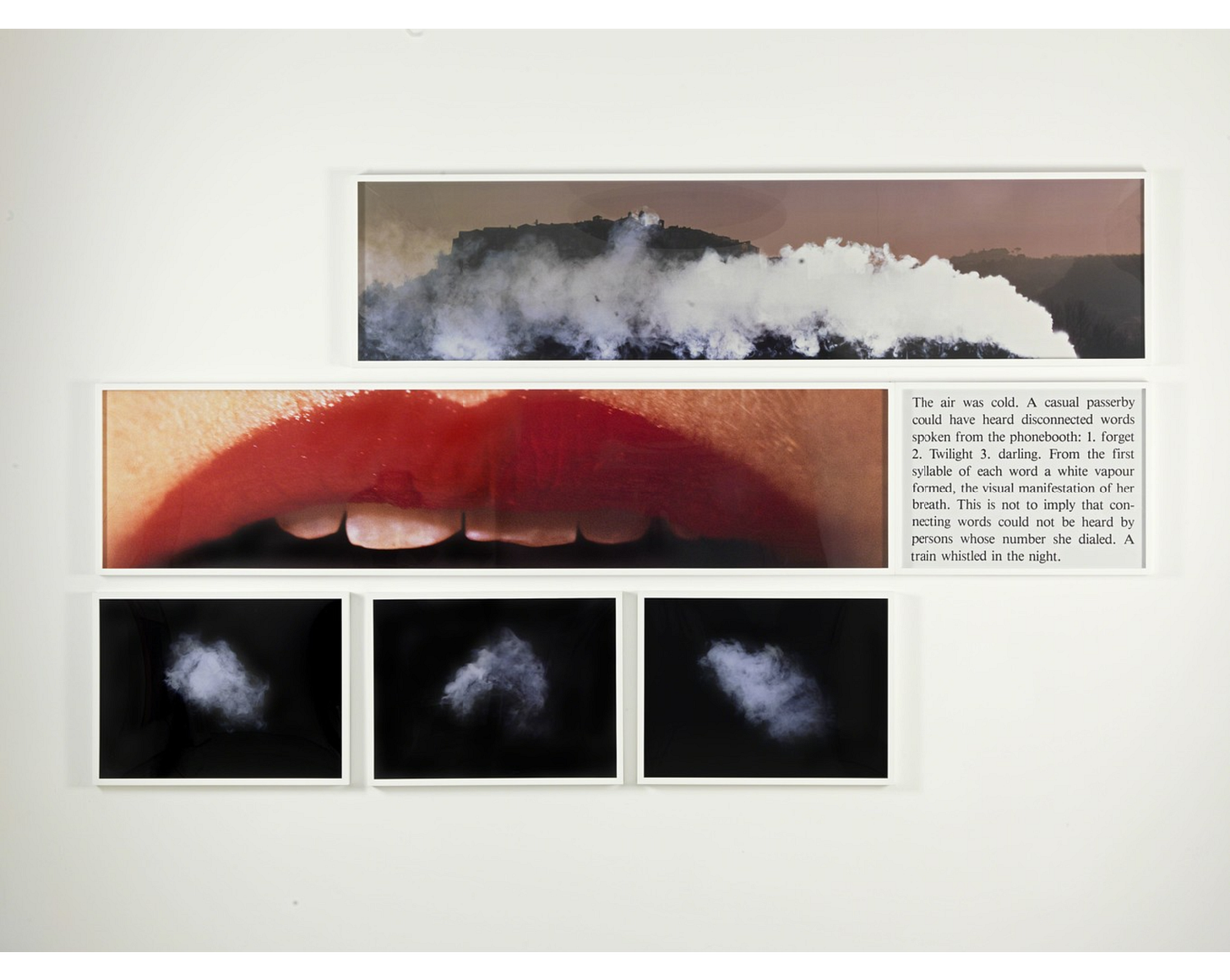
Beckley’s narrative artworks
Bill Beckley was an American artist who was born in 1946 in Pennsylvania. He studied art at two nearby universities, and in 1970 his work was included in the conceptual art exhibition “Art in the Mind.” The same year, he moved to NYC, and began to meet other artists that all made works that could loosely be described as narrative art. On his website, you can see all the works he made in the ‘70s: photographs that could be pristinely sharp and clear, almost like advertising images; or photographs that were more oblique and evocative. They were paired with texts, printed on white paper in a sober black sans serif, that felt like short, flash fiction–style stories.
Beckley wanted the images and text to have equal weight. Of the artwork above, he said,
Deirdre’s Lip…is a culmination of my so-called Story or Narrative works of the late sixties. In 1969, I began writing texts and simultaneously imagined images to make works that were both image and text—neither one having precedent over the other. The images do not illustrate the text and the texts do not explain the images—or at least I hope they don’t. They float together in undetermined space and function like a kiss. The Lip is fiction, not a documentation of an act performed elsewhere. With respect to scale, I wanted the piece to have a photographic presence compatible to painting and sculpture of that time. Conceptual art was a refreshing departure from the prison of Minimalism, a movement that many of us escaped from in the very late sixties. But the escape for me was like jumping from frying pan into fire. I was uncomfortable with Minimalism’s regiments and Conceptualism’s self-consciousness, seriousness, and sexlessness. I knew I could not go back to 19th century Romanticism, but I didn’t want to divorce myself from its pathos. A moral of the story, but not the only one: if you want a kiss, it’s good to give some lip.
Beckley’s stories avoid the “self-consciousness, seriousness, and sexlessness” of Conceptualism” by being subtly funny, and often narrating encounters between men and women, or introducing some element of eroticism—lips, lingerie, and legs are often mentioned in his stories. But it’s usually just alluded to in the text. In The Bathroom, for example, you get images suggesting that people were once present. But you don’t meet them; you merely witness the shoes, stockings, and mirror in a room.
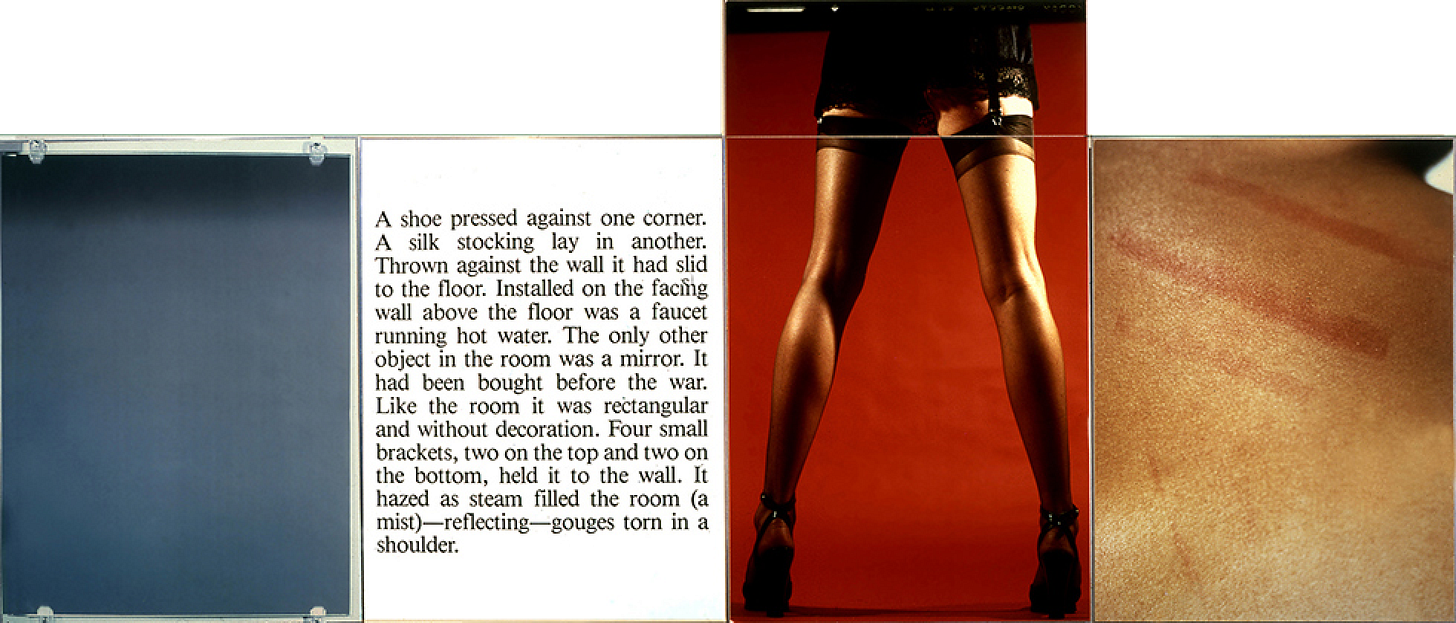
In other stories, there’s a clear protagonist—sometimes meeting a friend or a lover, and sometimes alone. Here, for example, is Beckley’s Cake Story (1973), which is part of the Hoffman collection:
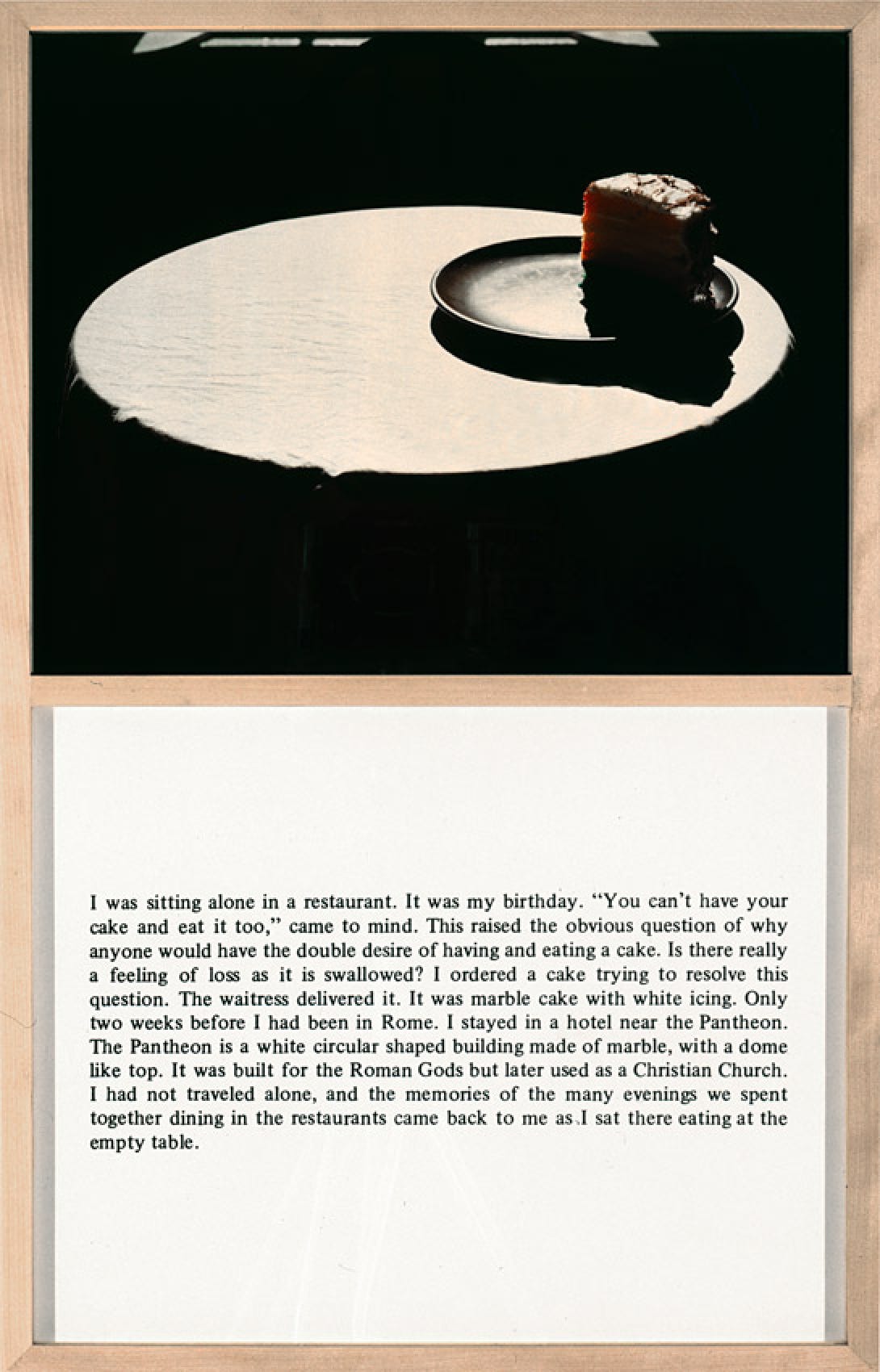
I love this story, because it’s so easy to be drawn into it. As soon as you read the first 2 sentences—I was sitting alone in a restaurant. It was my birthday—you’ve started to formulating theories, hypotheses, assumptions about the narrator.
These straightforward sentences—unelaborated, unadorned—are then followed by more ruminative, elongated ones:
“You can’t have your cake and eat it too,” came to mind. This raised the obvious question of why anyone would have the double desire of having and eating a cake. Is there really a feeling of loss as it is swallowed?
In 3 sentences, Beckley shifts to a more abstract, searching tone—it’s an exciting and invigorating surprise. And then he brings the reader back to the present moment: I ordered a cake trying to resolve this question.
I loved, too, how Beckley’s short texts often included a very precise, careful description of some visual scene. In this work, it’s the description of the Pantheon:
Only two weeks before I had been in Rome. I stayed in a hotel near the Pantheon. The Pantheon is a white circular shaped building made of marble, with a dome like top.
The description is simple, but it has the feeling of a visual artist’s roving eye—keenly observing the major compositional elements of the world.
During the tour of the collection, I kept on gravitating to Beckley’s works (especially Deirdre's Lip, made in 1978, which almost has a comic strip–style composition!) and when I came back from my holiday, I felt newly excited by photography and excited by short fiction. I don’t think of myself as a photographer; I don’t think of myself as a fiction writer. But Beckley’s work made me think: What if I just experimented? What if I just copied his approach and had fun with it?
Three stories in the style of Bill Beckley
I’ve written before about how taking inspiration from others—a form of deep copying, respectful and attentive—is a helpful way to practice creative skills:
But the other reason to do it is that it’s fun. It’s generative. It’s easy to get trapped in your own conventions (even if you’re new to a discipline), and it’s hard to realize the grand, sweeping scope of what’s possible to do with words and images.
And it’s hard, too, to get started. To try something new and not be afraid. Working in the style of another writer or artist is liberating; it frees you from making a thousand individual decisions, and lets you focus on practicing a few things. In this case, I didn’t have to face all the terrifying questions of: What kind of fiction do I want to write? Why do I want to write it? What kinds of characters, what kinds of scenes? I could borrow from Beckley and simply tell myself: When in doubt, observe Beckley’s work and copy from it.
I decided to make 3 works in the style of Beckley’s Cake Story. I gave myself some rules:
I had to write new texts, and I had to start and finish them in one sitting.
I could edit them after, as long as I didn’t overthink things or question whether the results were “good”—they just had to be good enough, given the constraints.
I could only use photos I’d taken myself.
I could only choose photos I’d taken in the last month.
“Was it better to be unpleasant or ugly?” ✦
For my first Beckley-inspired work, I began by looking closely at his first sentences. Many of them are very simple and observational:
“The carpet covered the floor,” in The Living Room (1977)
“The bus stopped at a red light,” in Bus (1976)
“I was sitting on a sofa,” in First Sexual Experience (1974)
Other pieces start with sentence explicitly about stories and storytelling:
“When I was younger I heard a joke,” in Joke About Elephants (1974)
“Some stories are short and some stories are long,” in Boat (1976)
“One way to end a story is to give it a sad ending,” in Sad Ending (1975)
So I began by writing, “I read a novel yesterday.” And here’s where I ended up:
I read a novel yesterday. The main character was a man who couldn’t bear to be alone. Each chapter featured a different companion, and who was tall, willowy, and beautiful. I was interested in these women, who kept departing from the story; I wanted to know what world they inhabited, and if they regretted being absent. A friend had also read the novel. His copy was in pristine condition because he always sold his books after reading them. My friend said the best companion was the first one. I disagreed and said I liked the last. We debated their merits: was it better to be dignified or funny, unpleasant or ugly, beautiful or happy? It was summer and the restaurant had given us a table outside. My glass of water had a fine sheen of condensation around it, and from the side you could see the veiled outline of the ice cubes inside. I wanted to finish my dinner and go home and lie down in front of the AC, but my friend was still speaking. He didn’t want to leave until I agreed with him.
The text
…is loosely about that strange phenomenon you’ll often see in TV shows, where there’s a consistent male protagonist but different women over time. (Pokémon does this, and Doctor Who. I’m sorry I don’t have any highbrow references. I haven’t watched that much TV since I was a child!) It’s also about how much I love discussing the characters of a book with other readers—it feels like gossiping!
Towards the end of the text, I couldn’t help but work in some of my angst about how unremittingly hot it’s been in London and NYC (where I was visiting for work last week.) I wanted to try and write an elegant description, which is where the sentence:
My glass of water had a fine sheen of condensation around it, and from the side you should see the veiled outline of the ice cubes inside.
—comes from, but now that I’m reading this a few days afterwards, it feels like there’s something wrong. (Is a sheen something that goes around a surface? Or is it on the surface? And the image of ice cubes vaguely visible through the condensation—it’s a good idea, but I’m not sure if I’ve pulled it off.)
But the point of these exercises isn’t to be perfect! It’s to experiment.
The photo
…is from a restaurant in Berlin. I was thinking about the opening sentence of Beckley’s Cake Story: “I was sitting alone in a restaurant.” It was the most obviously relevant photo in my camera roll.
“I didn’t like the DJ” ✦
I wrote my second Beckley-inspired work on a Wednesday afternoon, in between meetings. The nice thing about this exercise is that it’s short—I could just knock out a story in 15 minutes. I edited it on my phone when commuting home for the evening.
I wanted to write about someone who was alone, but halfway through I realized that it felt more interesting, and more invigorating, to have another second character involved!
I was walking home on a summer evening. I passed by dark, still forms: a tree, a bush, a fence. When I walked past one home I caught a trailing cloud of jasmine, sticky and carnal. I wanted to take a flower with me but I couldn’t see the plant. Earlier in the evening I had smoked a cigarette, in semidarkness, outside the club. The scent still clung to my shirt and I didn’t like it anymore. In the club I had spoken to no one, only danced, but when I emerged for air a stranger spoke to me. I didn’t like the DJ, he said. I don’t like this night. I don’t like the people. Because I disagreed with him I didn’t know what to say. Why do you come here, I said. He looked at me and asked if I had a light. I never come here, he said. I didn’t know what it was like.
The text
…is drawn from my memories of going out.
A few summers ago, I was visiting NYC and walking to a subway station after leaving Nowadays. I was tired and exuberant and still sticky with sweat when I passed by someone’s backyard. There must have been a jasmine vine clinging onto the fence, because I was immediately surrounded by the smell. I’ve always loved a white floral fragrance, and this felt like such a rare, beautiful moment—a 2am benediction. Later, I texted my friend Ari and said: I wish there were a perfume that captured the feeling of leaving the club, walking through cigarette smoke, and emerging into a cool summer night with jasmine blooming. It turns out there is a fragrance that is exactly this! It’s Etat Libre d’Orange’s Jasmin et Cigarette.
On a different trip to NYC (I’m there a lot for work!) I went to public records for a DJ Sprinkles set and had a deeply strange conversation with a Dutch guy who had just moved to the city. He said something about how he wasn’t impressed by NYC techno, because “I came here from Amsterdam, and we basically invented techno.” So I was thinking about people who annoy me on the dance floor, and how I need to get better at drifting away from conversations like that. It’s hard for me because I love speaking to strangers and it nearly always goes well.
When I’m in the smoking area of a club, people will sometimes ask me for a lighter, and I always feel immensely sad and apologetic when I have to say no. I only smoke when I drink, as the Off-White t-shirt says, and no more than three cigarettes a year.
The photo
…is from my mid-July work trip to NYC, when I passed by a mattress on the street, covered in vinyl, with tiny flowers scattered on top. The rippled shadows in the top half of the photo have the still, balanced quality of a landscape.
“At least it wasn’t my fault” ✦
For my third and final Beckley-inspired story, I decided to write my own Cake Story. (And I bent one of my rules—this photo is from May.)
The date wasn’t going well. At least it wasn’t my fault. It also wasn’t my problem because I was observing from another table, halfway across the restaurant. I pretended I couldn’t decide on my entrée. I pretended I was reading a book. The man was looking at his phone and the woman was on her third glass of wine. I couldn’t hear anything. They looked sad and a little lonely, like they no longer knew how to be together. When the woman raised the glass to her lips her wrist flashed in the light. I tried to count the carats. Maybe her next lover would be richer. Or maybe he would be poorer, but she would be happier.
The text
…is about my number one hobby, eavesdropping on strangers. (A more virtuous way to put it: I’m training my ear for dialogue, in case I ever want to write fiction.) But sometimes I can’t hear anything and I have to content myself with mere observation. I love seeing what people are wearing; I love guessing who’s on a date at a restaurant; I’m always sad when I see a couple where both people are on their phones, scrolling, a little fatigued by each other.
I was thinking about diamond jewelry when I wrote these sentences:
When the woman raised the glass to her lips her wrist flashed in the light. I tried to count the carats.
I was trying to describe, obliquely, that she had a diamond bracelet. I’m not sure if I pulled it off. Maybe I could strike out “in the light,” so the sentence ends on a sharp, clean verb: “When the woman raised the glass to her lips, her wrist flashed.” (I also added a comma; maybe it reads better that way?)
The photo
…is a coconut panna cotta from abcV in Manhattan. The story isn’t autofiction, by the way. I had dinner there with my friends Nat and Will, and we had the loveliest conversation; I wasn’t paying attention to anyone else around us.
Make your own Beckley-inspired work!
The two greatest hurdles in writing more, in my opinion, are:
“I don’t have enough time”
“I don’t know what to do”
The nice thing about copying Beckley’s approach is that some of the works, especially Cake Story, are very simple (one image! one paragraph!) and evocative. And using someone else’s work as a starting point is a great way to feel less pressure about having the perfect idea, characters, plot—I think this is why fan fiction is such an useful way for people to practice writing.
If you end up writing a Beckley-inspired story, I’d love to hear! And if you’re curious how I made the images, I’ve left instructions in the footnotes.2 If there’s interest, I’ll try to clean up my untidy working file into a downloadable wood texture + Figma template that you can use for your own Beckley-inspired art!.
Four recent favorites
Your favorite footballer’s favorite novels ✦✧ Fiona Banner’s flags ✦✧ Write by hand (the results are worth it) ✦✧ How to make a deep techno track in 5 hours
Your favorite footballer’s favorite novels ✦
It turns out that Héctor Bellerín, who played for Arsenal for 9 years, has excellent taste in books. His latest Instagram posts feature:
Alana Portero’s debut novel Bad Habit, about about a working-class trans girl in Madrid (the filmmaker Pedro Almodóvar is a fan!)
The Argentinian novelist Samanta Schweblin’s Little Eyes
The Nobel literature laureate Han Kang’s The Vegetarian
Leslie Jamison’s essay collection from 2014, The Empathy Exam
and Naomi Klein’s Doppelganger (which I discuss in my essay on conspiracy theories for the Cleveland Review of Books!)
Lanre Bakare has a charming article in the Guardian about where Bellerín gets his book recs:
The footballer gets recommendations from a writing group he attends every Tuesday night in Seville. Made up of students, doctors and engineers, the group has introduced him to the contemporary Spanish literary scene.
“We feed off each other, recommending books and movies. My taste has also changed, because the people I’ve got around me have great taste and give great recommendations, new names and new faces and new ways of writing.”
Fiona Banner’s flags ✦
Speaking of Arsenal (well, sort of)—my friend Maanav introduced me to the artist Fiona Banner, whose Disarm Flags is a site-specific work for Art Basel Parcours. Banner’s flags—which feature body parts emblazoned with words like ALLEGATION, DELEGATION, OBSOLETE, ARSENAL, DISARM—were placed on a Rhine river bridge.
Banner also refers to Disarm Flags as a publication, complete with an ISBN (978-1-913983-35-2).
Write by hand (the results are worth it) ✦
I’m obsessed with these flyers, designed by Salvatore La Rosa, for Salvo’s Cucina Casalinga in Ridgewood. In particular, I love the elegant/exuberant insouciance of 12pm–sold out in the flyer below—
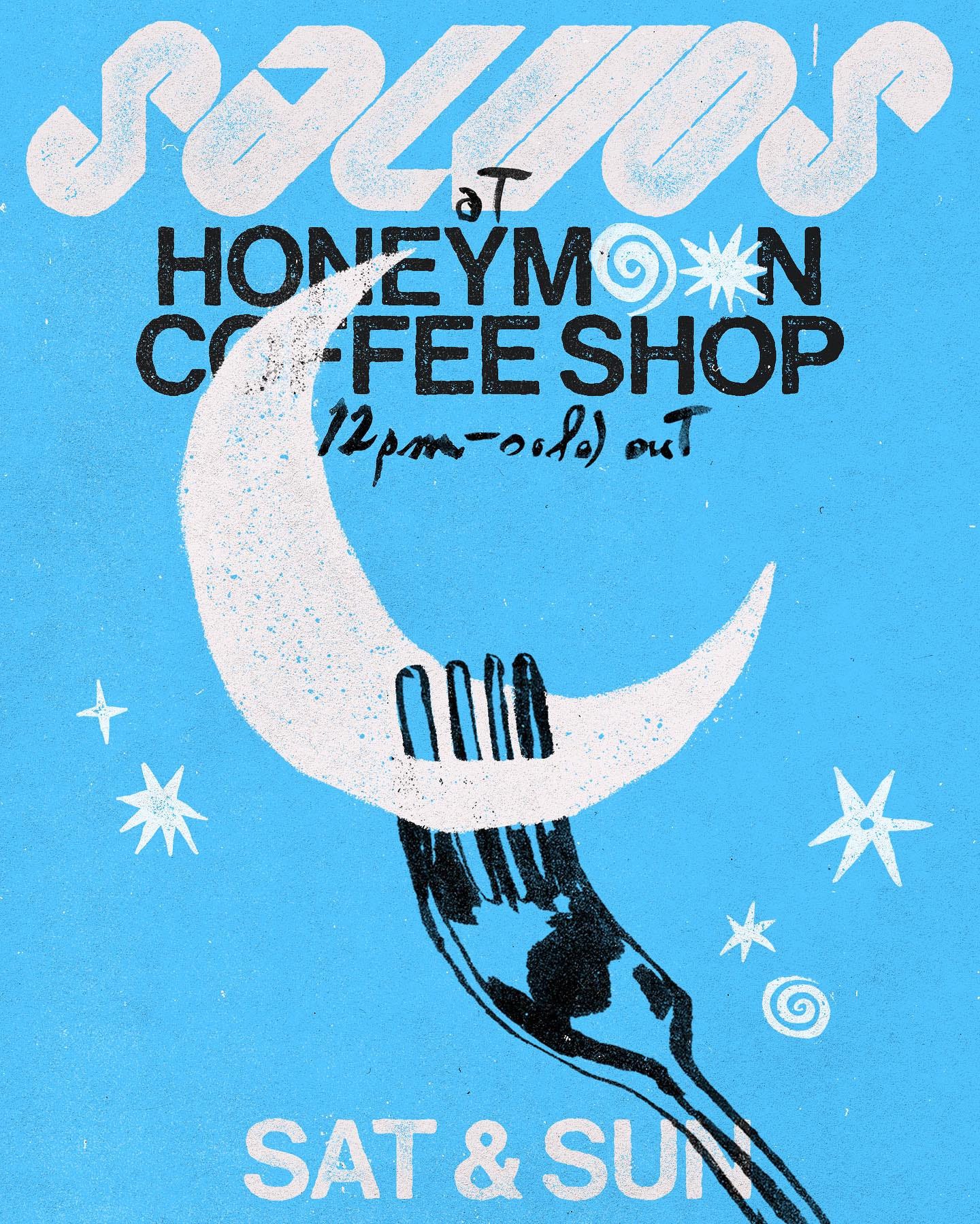
—and the thin-to-thick script of Mortadella below (the way the elegant, precise Mor is followed up by the thickly textured strokes of the t, and the idiosyncratic double l’s later on):
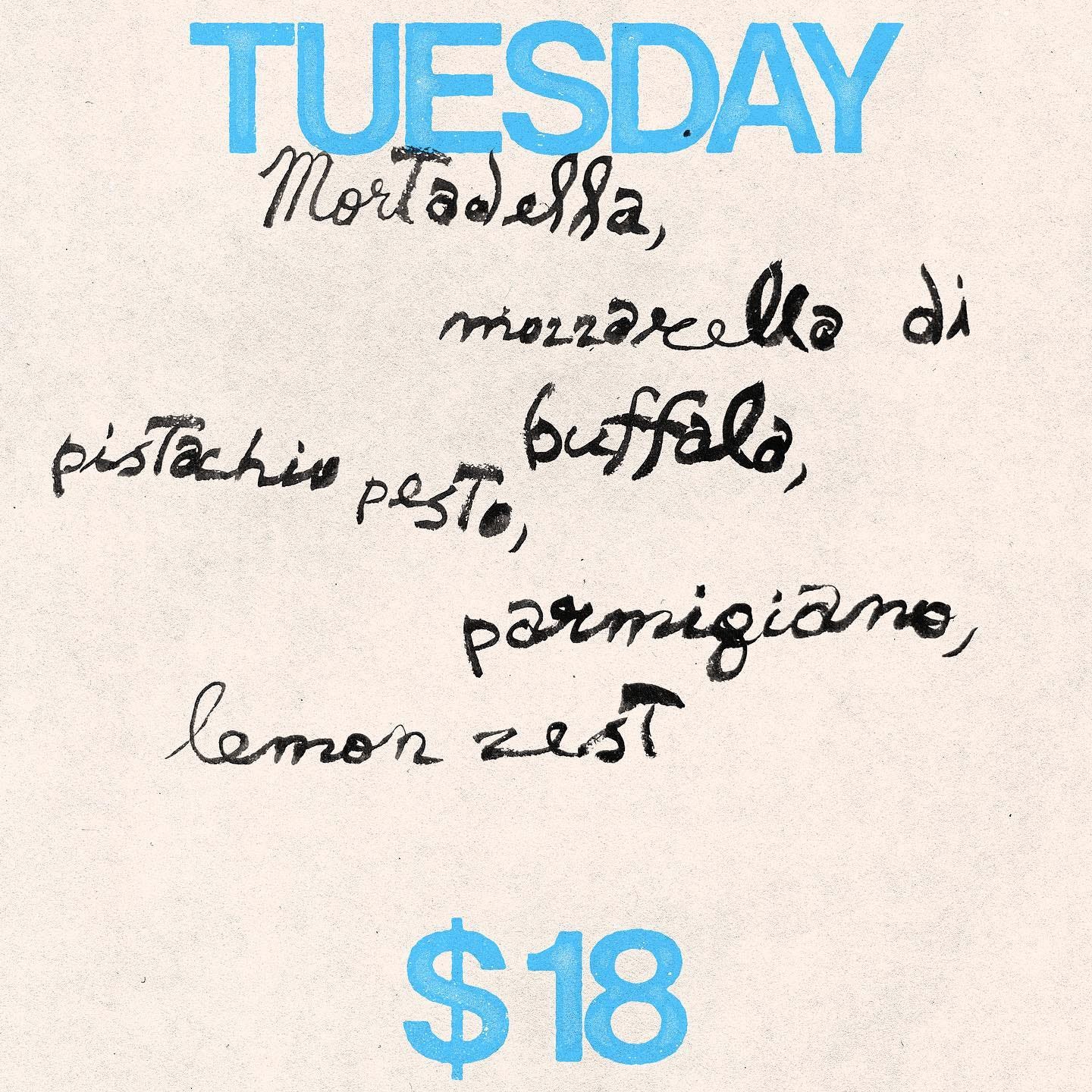
How to make a deep techno track in 5 hours ✦
Polygonia is a Munich-based artist and producer whose music is “psychedelic, textural and plays spatial tricks on the brain,” as Andrew Ryce, the former editor of Resident Advisor, described in a newsletter last year.
She’s one of my favorite producers, but I somehow missed her track “Synaptic Paths,” which feels like a steady, thrumming expedition to an expansive, forested landscape—with the notes bouncing off the tree canopy and gathering at your feet.
There’s also a 5 hour–long video of how Polygonia made the track, from start to finish. I really don’t need another interest in my life (I’m barely able to keep up with this newsletter!) but I’m bookmarking this for my next quarter-life crisis, when I decide that I need to self-actualize through making electronic music.
Thank you all for reading! This is a shorter newsletter than my usual—which is nice, honestly. I’ve been mildly sleep-deprived all week, and it feels good to do something fresh and unfamiliar (writing fiction!) that also takes up very little time.
And please write to me (by replying to this email, or leaving a comment below) about your own creative exercises! Poems written in the Notes app during your commute; fan fiction that you’re afraid to show anyone but are furtively proud of; copying quotes from your favorite writers; sketching strangers and friends as practice; 30-day challenges to make something every day.
What I’ve started to believe about acclaim is that:
It is not necessarily meritocratic. The most artistically “deserving” works (whatever that may mean to you) do not necessarily receive more attention than the mediocre ones (again: it’s whatever that means to you). This pains me a great deal sometimes, which is why I make an extra effort to mention my favorite books, constantly, so that at least someone is out there relentlessly advocating for them.
It does, however, operate in a relatively predictable manner. One of the most predictable aspects of acclaim (or even minor internet fame) is that it accrues to people who actually finish projects and then put those projects out in the world. So there are two necessary aspects: doing the work, and finding a tolerable way to promote the work.
It’s obviously ridiculous (though psychologically very understandable, and worth approaching with gentleness and compassion) when people feel envious of other people’s creative success, but are not finishing projects of their own. Mediocre work is easier to appreciate than an absence of work.
But what is also ridiculous (though, again, psychologically understandable!) is when people do finish projects—but maybe just one or two—and then wait patiently for the acclaim to suddenly descend around them, so that, ennobled and anointed by the gatekeepers, they can settle comfortably into a lifetime of success.
And when it doesn’t happen—the immediate success, the instant gratification—it’s way too easy for people to interpret it as: People don’t like good work, because this was my best work, and no one cares. Or: People don’t like good work, because my work is better than other things that are more popular. And this attitude can eventually calcify into genuine resentment; because these are all defensive postures to avoid the most terrifying interpretation of all: My work is actually not that good, because if it was, it would be recognized immediately. And since I have not received recognition, I might as well give up.
There’s an alternate interpretation, which is: People like good work, mostly, but it takes a while for them to find it. So I should practice getting better at the work, and I should practice getting better at bringing it to an audience. But to get to this interpretation, it helps to not carry the resentful belief that you are an afflicted, under-recognized genius.
I keep on thinking about something the artist Chitra Ganesh said in a 2023 article in Cultured, about where artistic success comes from:
People are often under the misimpression that someone from a higher plane of power will come and pluck them out of their current circumstances, catapulting them to success. While the 'chosen one' narrative may happen once in a blue moon, the vast majority of success happens with the discipline of a daily grind, and networks of peers who lift each other up, on a regular basis, over years.
I used Photoshop and Figma to make the fake framed artworks:
First, I made the fake wood texture in Photoshop by setting my foreground color to
#e3d7c1(a light birch-y tone), my background color to#b8a082(a few shades darker, almost like a very milky latte), and then using Filter/Render/Fibers and playing around with the settings.I exported the texture at a fairly large size, around 4000px by 4000px, and then brought it into Figma.
I created the frame and arranged the photographs plus texts there. For the frames, I created 5 individual rectangles (for the left, right, top, bottom, and center frame pieces) and applied my texture as a fill. This gets you rectangles that look plausibly made of wood.
I then arranged the rectangles into a frame shape, and put the images and texts underneath. To make it look realistic, you’ll also want to:
Miter the corners of your fake frame (so take either the left + right, or the top + bottom rectangles, and cut the corners into a triangular shape)
Make the frame look 3D and slightly beveled. I added 4 inner shadow effects so the wood looks more dimensional, and 2 outer shadow effects so that the frame looks like it’s casting a slight shadow on the photographs and text.
I also added a drop shadow to the grouped elements (frame + text + image) so that it looks a bit nicer in this post.



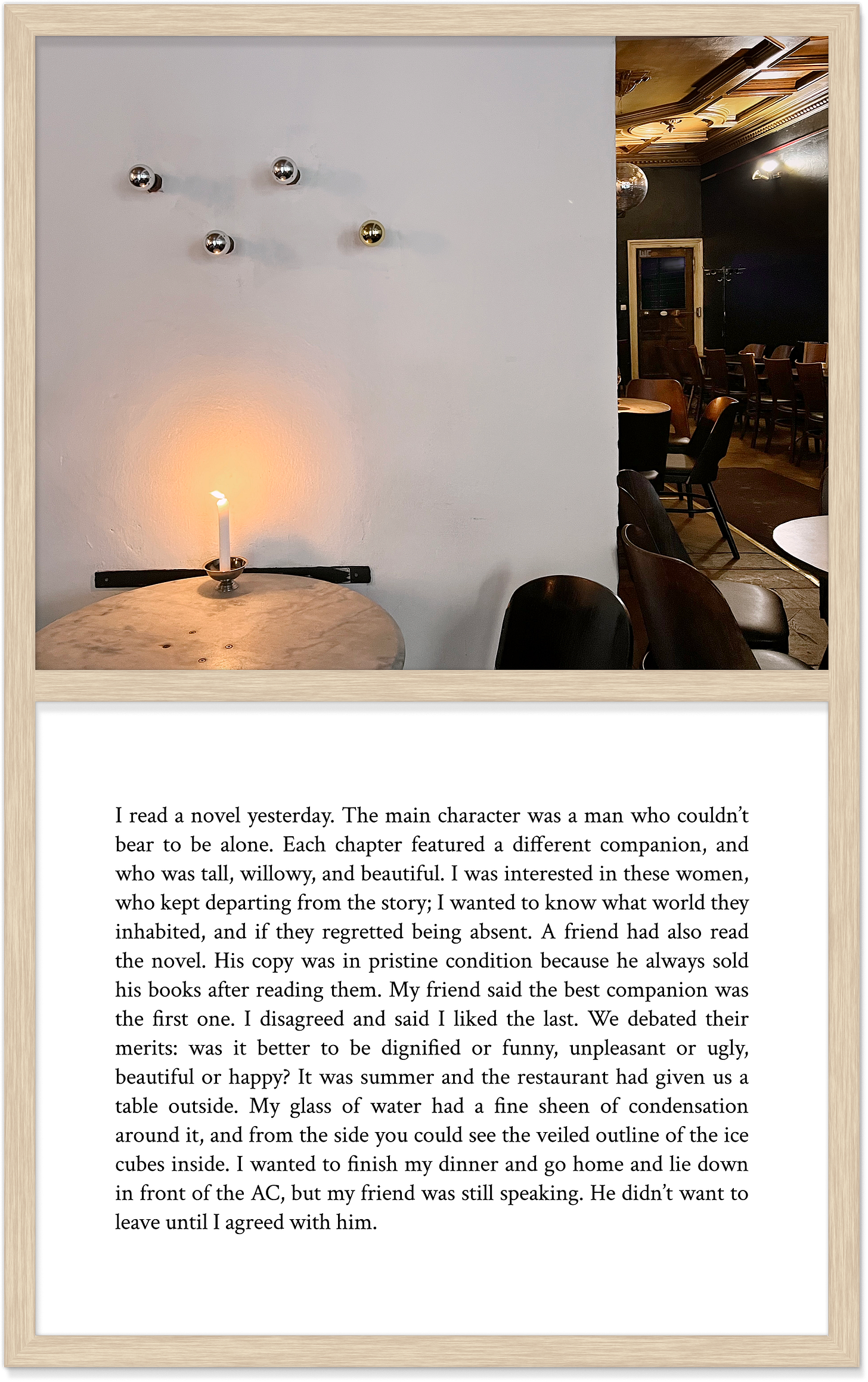
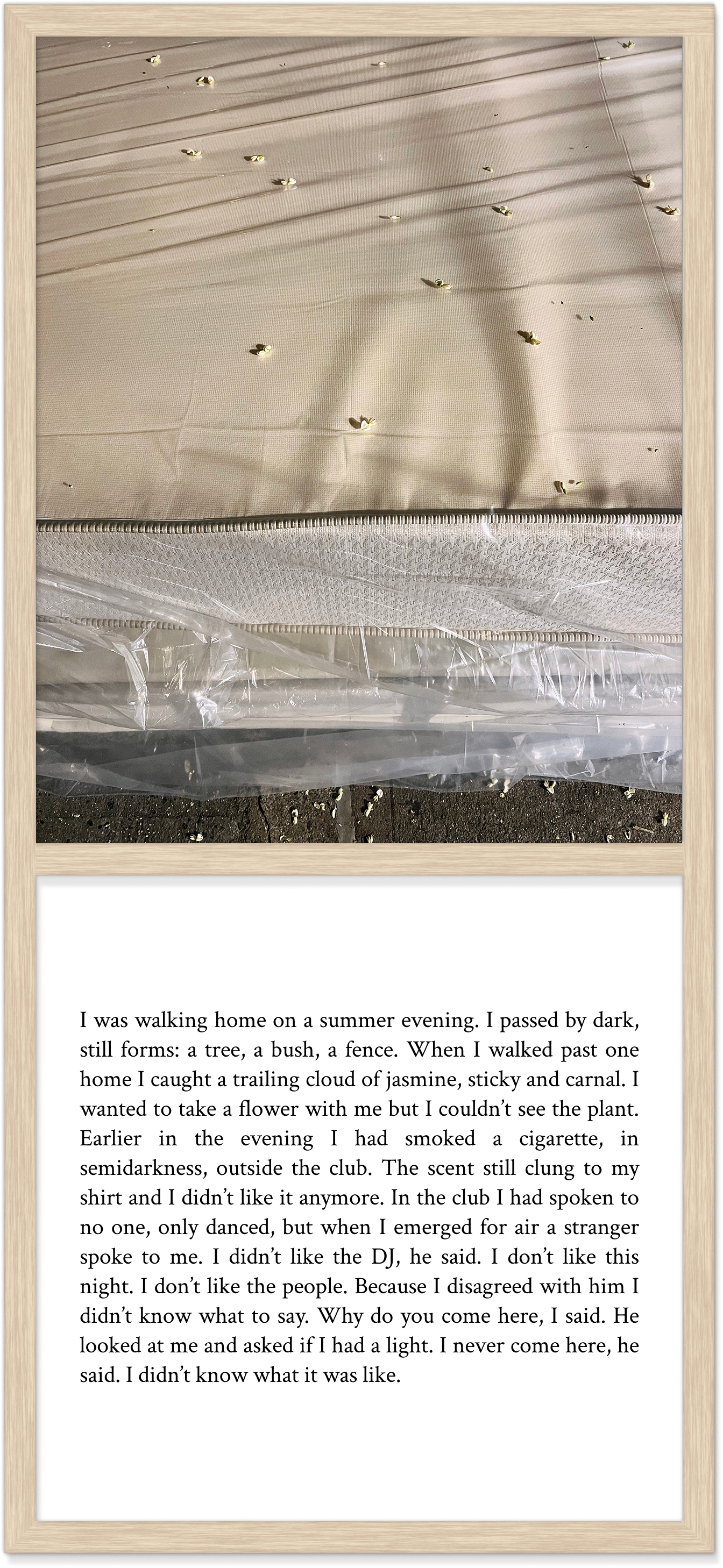
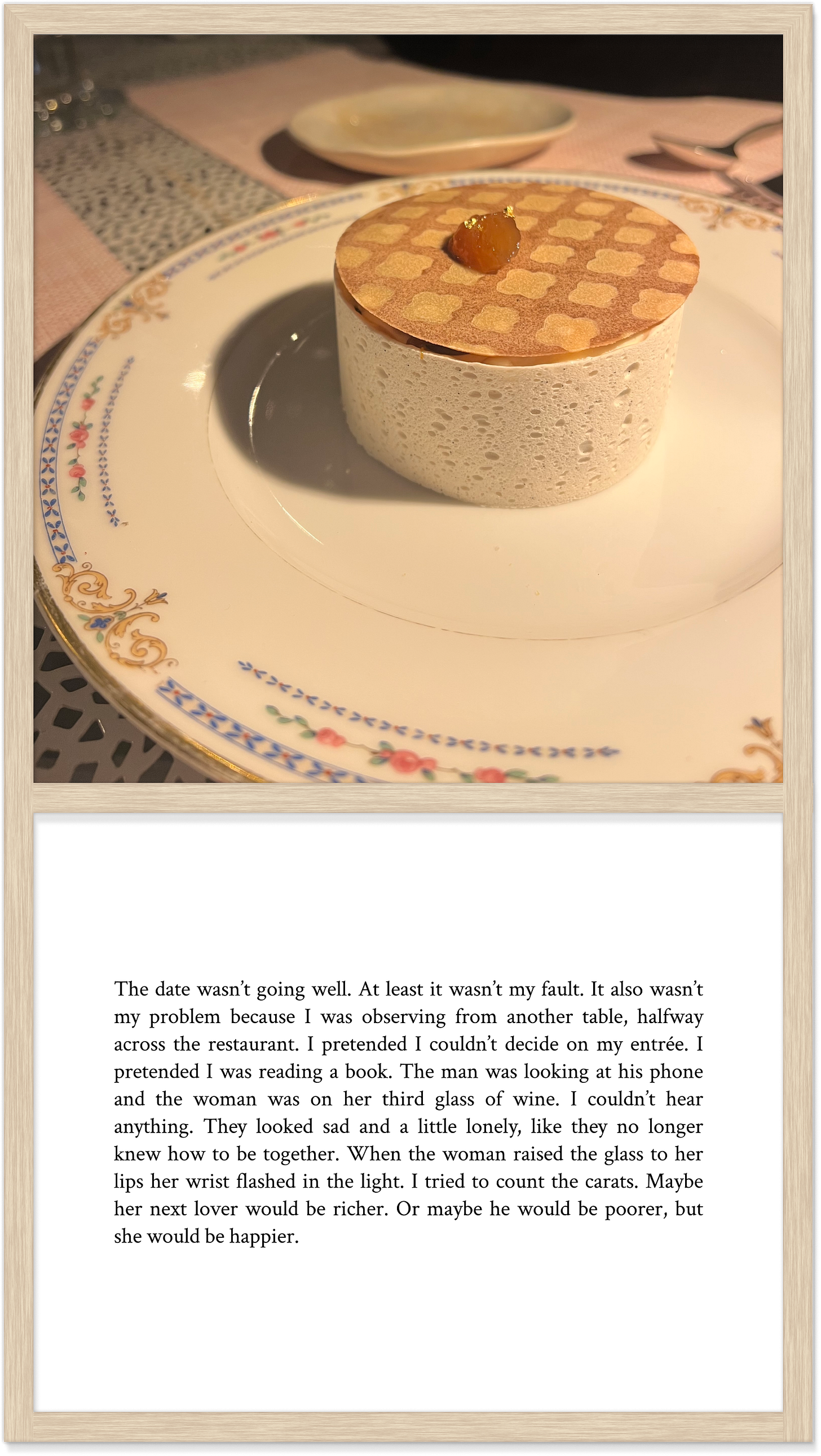
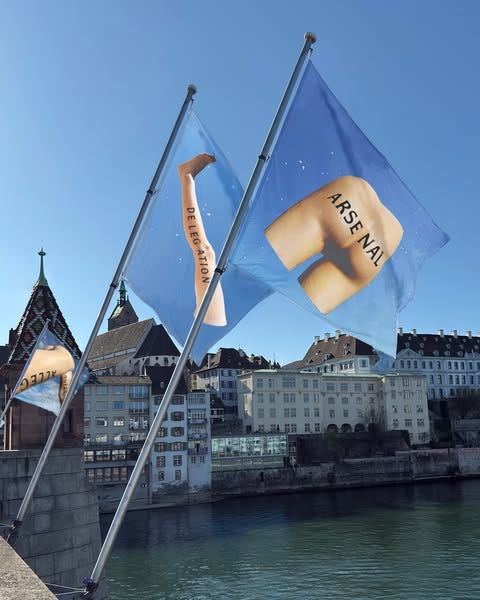
I've always been a fan of text-visual crosses like this, though I'd not heard of Beckley. Thanks so much for the inspiring post! I tried a Beckley-style story too: https://substack.com/@josephayoung/note/c-138906024
As someone just beginning to write fiction, I adored this! I was really inspired by this piece and threw together a little website to share flash fiction in this form: https://flashfiction.neocities.org/. It currently only has one quick one I threw together and Bill Beckley's pieces, so I would love to put the pieces you shared in this essay on this website with your permission. Anyone reading this can also submit any flash fiction of this style to the website!